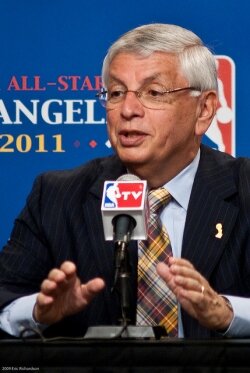Cold turkey: Imagine life without the NBA and NFL
Saturday, February 19, 2011: remember that day. Circle it with a red pen on your calendar, and mark it with a big X. Come next fall when you realize you’ve spent all weekend watching the pre-teen mid-level-amateur Upper Peninsula Figure Skating quarterfinals, you’ll want to remember how you got there.
Saturday, February 19, 2011: the day the seasons died.
The same day NFL Commissioner Roger Goodell and Players Association executive director DeMaurice Smith spent six hours in a room with a federal mediator trying to hash out a collective bargaining agreement, NBA Commissioner David Stern spent an hour telling the press that there might not be a single professional basketball game played next season.
No NFL, no NBA. It’s just the excuse Bud Selig needs to extend baseball into December. Wild-Card games on Thanksgiving afternoon– now that’s American. If baseball isn’t your thing (but what choice will you have really?), Canadian Thanksgiving falls on Monday, October 10, this year, right around the time the NHL season starts. That sounds good, doesn’t it? You can get through the year without the NFL and the NBA, right?
If you think it will never come to that, think again. If you were alive and alert from August 12, 1994, to April 2, 1995, you already know the drill.
Almost 950 major league baseball games were cancelled then, and 1994 was the first year without a World Series since 1904. The MLB lost a billion dollars that year, and millions of fans never returned. There were players– even Hall of Famers like Goose Gossage– who never played another game after the strike. It was awful all the way around, and the MLB still hasn’t recovered.
The NFL and NBA are so omnipresent they seem an intrinsic part of our lives, but the reality is they're businesses just like Morgan Stanley was a business. And we all know what happened to them.
And just like Morgan Stanley, all this money the NFL and NBA are haggling over comes from one place: us. If the two leagues can’t or won’t reach agreements with their players’ unions, and the 2011-2012 season goes unplayed, how many fans won’t come back?
You may think the NFL won’t risk it, not after seeing how baseball suffered, but don’t count on it. The NFL has enough faith in its fans to screw them to the wall, and enough of an ego to believe they’ll come back for more.
Roger Goodell and team owners, the main cause of the brouhaha, want a lot, including new stadiums in Los Angeles, Minnesota, Arizona, New Orleans, New York, Atlanta, and San Diego. But the NFL’s annual revenue of $9 billion isn’t enough.
To accomplish their goals, the NFL and team owners plan to withhold billions in future revenue from the players and expand the season to make more money for themselves. Team owners have hired as their point man the attorney who managed the NHL's 2004 lockout of its players; does that sound like they won’t risk losing fans?
The NBA’s problem is cutting dead weight. Any league that keeps the L.A. Clippers around deserves all the financial trouble it gets. The NBA spends its own money keeping the New Orleans Hornets above water, and yet professes to want “a sustainable business model.”
Revenue-share all you want, but with 30 teams, the NBA is almost hopelessly overextended, and David Stern, for all his talk of contraction, seems unwilling to take the tiger by the tail.
If you don’t already like pre-teen amateur ice skating championships, you might want to develop a taste. On February 19, 2011, David Stern offered a very real possibility for the future of both the NBA and the NFL.
“What we have learned, and what the union has learned, is that we both have the capacity to shut down the league,” said Stern. “There's no magic that's going to keep this league operating if we don't make a deal.”
~
Juanita Giles lives on a farm in Charlotte County with her husband, son and many dogs.
